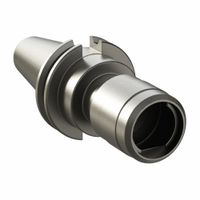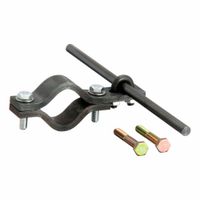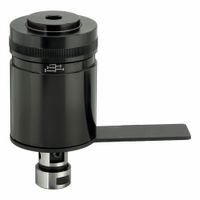Call +(254) 703 030 000 / 751 483 999 / 721 704 777
- Home
- Machining
- Toolholding Tooling Systems
- Tapping Heads Holders
.....Read More
Frequently Asked Questions
What is a tapping head and how does it work?
A tapping head is a specialized tool used in machining to automate the process of cutting threads inside a hole, known as tapping. It is typically attached to a drill press, milling machine, or CNC machine. The primary function of a tapping head is to hold and drive a tap, which is a tool used to cut the female portion of a mating pair (e.g., a nut).
The tapping head works by allowing the tap to move axially and rotate simultaneously. It consists of several key components: a chuck to hold the tap, a clutch mechanism, and a reversing mechanism. The clutch allows the tap to slip if it encounters excessive resistance, preventing breakage. The reversing mechanism automatically changes the direction of the tap's rotation when it reaches the desired depth, allowing it to back out of the hole.
When in operation, the machine spindle rotates the tapping head, which in turn rotates the tap. As the tap cuts threads into the material, the axial movement is controlled by the tapping head's feed mechanism, ensuring consistent thread depth and pitch. The reversing mechanism is typically activated by reaching a preset depth or by a manual switch, causing the tap to reverse direction and exit the hole.
Tapping heads improve efficiency and accuracy in thread cutting by reducing manual labor and minimizing the risk of tap breakage. They are especially useful in production environments where multiple holes need to be tapped quickly and consistently.
How do you choose the right tapping head for a specific machine?
To choose the right tapping head for a specific machine, consider the following factors:
1. **Machine Compatibility**: Ensure the tapping head is compatible with the machine's spindle type and size. Check the machine's power, speed, and torque capabilities to match the tapping head's requirements.
2. **Tapping Requirements**: Determine the thread size, pitch, and depth required for the application. Choose a tapping head that can accommodate these specifications.
3. **Material Type**: Consider the material being tapped. Different materials require different tapping speeds and torque. Ensure the tapping head can handle the material's hardness and ductility.
4. **Type of Tapping Head**: Decide between a rigid, floating, or self-reversing tapping head. Rigid heads are suitable for machines with synchronized spindles, while floating heads compensate for minor misalignments. Self-reversing heads are ideal for high-speed production.
5. **Speed and Torque**: Evaluate the tapping head's speed range and torque capacity. Ensure it aligns with the machine's capabilities and the material's requirements.
6. **Size and Weight**: Consider the size and weight of the tapping head to ensure it fits within the machine's workspace and does not exceed the machine's load capacity.
7. **Ease of Use and Maintenance**: Choose a tapping head that is easy to set up, operate, and maintain. Look for features like quick-change collets and easy adjustment mechanisms.
8. **Cost and Brand**: Consider the budget and choose a reputable brand known for quality and reliability. Balance cost with the features and durability required for the application.
9. **Technical Support and Warranty**: Ensure the manufacturer offers good technical support and a warranty for the tapping head.
By evaluating these factors, you can select a tapping head that optimizes performance and efficiency for your specific machine and application.
What are the differences between tapping heads and tap chucks?
Tapping heads and tap chucks are both used in machining processes to create threads in holes, but they serve different purposes and have distinct features:
1. **Functionality**:
- **Tapping Heads**: These are specialized tools designed for high-speed, efficient tapping operations. They automatically reverse the tap out of the hole after the thread is cut, which increases productivity and reduces cycle time.
- **Tap Chucks**: These are holders for taps, providing a secure grip during manual or machine tapping. They do not have automatic reversing capabilities and are generally used for more controlled, precise tapping operations.
2. **Design**:
- **Tapping Heads**: Typically feature a clutch mechanism that allows for automatic reversal and torque control. They are often used in production environments where speed and efficiency are critical.
- **Tap Chucks**: Simpler in design, they securely hold the tap and may include features like adjustable torque settings or length compensation, but lack the automatic reversing feature.
3. **Applications**:
- **Tapping Heads**: Ideal for repetitive, high-volume tapping tasks in industrial settings. They are often used in CNC machines and other automated systems.
- **Tap Chucks**: Suitable for both manual and machine tapping, especially in applications requiring precision and control, such as in repair work or low-volume production.
4. **Cost**:
- **Tapping Heads**: Generally more expensive due to their complex mechanisms and automation features.
- **Tap Chucks**: More cost-effective, especially for smaller operations or where automation is not required.
5. **Ease of Use**:
- **Tapping Heads**: Require less operator intervention once set up, making them easier to use in automated environments.
- **Tap Chucks**: Require more manual control and are better suited for skilled operators who need to adjust for different tapping conditions.
How do you install a tapping head on a milling machine?
To install a tapping head on a milling machine, follow these steps:
1. **Select the Tapping Head**: Choose a tapping head compatible with your milling machine's spindle and the size of the taps you intend to use.
2. **Prepare the Machine**: Ensure the milling machine is turned off and unplugged. Clean the spindle and the tapping head to remove any debris or oil.
3. **Install the Collet or Adapter**: If your tapping head requires a specific collet or adapter, install it into the machine's spindle. Ensure it is securely fastened.
4. **Attach the Tapping Head**: Align the tapping head with the spindle or adapter. Insert the shank of the tapping head into the spindle or adapter, ensuring it fits snugly.
5. **Secure the Tapping Head**: Use the appropriate drawbar or locking mechanism to secure the tapping head in place. Tighten it to prevent any movement during operation.
6. **Adjust the Depth Stop**: Set the depth stop on the tapping head to control the depth of the tap. This prevents over-tapping and potential damage to the workpiece.
7. **Set the Machine Speed**: Adjust the milling machine's speed to match the requirements of the tap size and material. Refer to the tapping head's manual for recommended speeds.
8. **Test the Setup**: Before starting the actual tapping process, perform a test run on a scrap piece to ensure everything is functioning correctly.
9. **Begin Tapping**: Once satisfied with the setup, proceed with tapping the workpiece. Monitor the process to ensure smooth operation and make adjustments if necessary.
10. **Maintenance**: After use, clean the tapping head and machine to maintain performance and longevity.
By following these steps, you can effectively install and use a tapping head on a milling machine.
What maintenance is required for tapping heads and holders?
Maintenance for tapping heads and holders involves several key steps to ensure optimal performance and longevity:
1. **Regular Cleaning**: Remove any chips, debris, and coolant residues from the tapping heads and holders after each use. Use compressed air or a soft brush to clean hard-to-reach areas.
2. **Inspection**: Frequently inspect the tapping heads and holders for signs of wear, damage, or corrosion. Check for cracks, worn threads, or any deformation that could affect performance.
3. **Lubrication**: Apply appropriate lubricants to moving parts to reduce friction and wear. Ensure that the lubrication is compatible with the materials and operating conditions.
4. **Alignment and Calibration**: Regularly check the alignment of the tapping heads and holders to ensure precision. Misalignment can lead to poor thread quality and increased wear.
5. **Tightening and Adjustment**: Ensure that all components are securely tightened and adjusted according to the manufacturer's specifications. Loose parts can lead to inaccuracies and potential damage.
6. **Replacement of Worn Parts**: Replace any worn or damaged parts immediately to prevent further damage and maintain performance. This includes springs, collets, and other consumable components.
7. **Storage**: Store tapping heads and holders in a clean, dry environment to prevent rust and corrosion. Use protective covers or cases when not in use.
8. **Documentation**: Keep a maintenance log to track inspections, repairs, and replacements. This helps in identifying patterns of wear and planning preventive maintenance.
9. **Training**: Ensure that operators are trained in proper handling and maintenance procedures to prevent misuse and extend the life of the equipment.
10. **Manufacturer Guidelines**: Follow the manufacturer's maintenance guidelines and schedules for specific models to ensure compliance with warranty and performance standards.
Can tapping heads be used with both drill presses and milling machines?
Yes, tapping heads can be used with both drill presses and milling machines. Tapping heads are specialized tools designed to automate the process of cutting threads into pre-drilled holes. They are versatile and can be adapted to various machines, including drill presses and milling machines, to enhance productivity and precision in tapping operations.
When used with a drill press, a tapping head allows for efficient and consistent thread cutting. The drill press provides the necessary vertical motion and stability, while the tapping head manages the rotation and feed rate, ensuring that the tap enters and exits the hole smoothly. This setup is ideal for straightforward tapping tasks where the workpiece is stationary and the holes are aligned vertically.
In milling machines, tapping heads offer additional flexibility. Milling machines, with their multi-axis capabilities, can handle more complex workpieces and tap holes at various angles. The tapping head can be mounted on the spindle of the milling machine, allowing for precise control over the tapping process. This is particularly useful in CNC milling machines, where automated control can optimize the tapping cycle, adjust speeds, and reverse the spindle direction as needed.
Both applications benefit from the tapping head's ability to reduce tap breakage and improve thread quality. The clutch mechanism in many tapping heads prevents over-torquing, while the self-reversing feature ensures efficient withdrawal of the tap. This makes tapping heads a valuable addition to both drill presses and milling machines, enhancing their functionality and expanding their range of applications in manufacturing and metalworking environments.
What are the common problems and solutions when using tapping heads?
Common problems when using tapping heads include:
1. **Misalignment**: Tapping heads can become misaligned with the workpiece, leading to poor thread quality or broken taps.
- **Solution**: Ensure proper alignment by regularly checking and adjusting the setup. Use alignment tools and fixtures to maintain precision.
2. **Inadequate Lubrication**: Insufficient lubrication can cause excessive wear and tear on the tapping head and taps.
- **Solution**: Use appropriate cutting fluids and ensure they are applied consistently. Regularly check and refill lubrication systems.
3. **Incorrect Speed and Feed Rates**: Using incorrect speed and feed rates can result in poor thread quality or tap breakage.
- **Solution**: Follow manufacturer recommendations for speed and feed rates based on material and tap size. Adjust settings as needed for specific applications.
4. **Worn or Damaged Taps**: Taps can wear out or become damaged, leading to poor performance.
- **Solution**: Regularly inspect taps for wear and replace them as needed. Use high-quality taps suitable for the material being worked on.
5. **Improper Depth Control**: Inconsistent thread depth can occur if the tapping head is not properly set.
- **Solution**: Use depth control mechanisms and regularly calibrate them to ensure consistent thread depth.
6. **Chip Accumulation**: Chips can accumulate in the tapping area, causing blockages and poor thread quality.
- **Solution**: Implement effective chip removal systems, such as air blasts or coolant flushes, to keep the area clear.
7. **Machine Vibration**: Excessive vibration can affect thread quality and tool life.
- **Solution**: Ensure the machine is properly maintained and balanced. Use vibration-dampening mounts if necessary.
By addressing these common issues with appropriate solutions, the efficiency and quality of tapping operations can be significantly improved.



